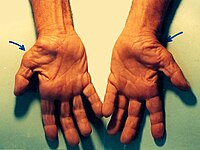
Photo from wikipedia
The sensorimotor and histological aspects of peripheral neuropathies were already studied by our team in two rat models: the sciatic nerve crush and the Charcot-Marie-Tooth-1A disease. In this study, we… Click to show full abstract
The sensorimotor and histological aspects of peripheral neuropathies were already studied by our team in two rat models: the sciatic nerve crush and the Charcot-Marie-Tooth-1A disease. In this study, we sought to highlight and compare the protein signature of these two pathological situations. Indeed, the identification of protein profiles in diseases can play an important role in the development of pharmacological targets. In fact, Charcot-Marie-Tooth-1A rats develop motor impairments that are more severe in the hind limbs. Therefore, for the first time, protein expression in sciatic nerve of Charcot-Marie-Tooth-1A rats was examined. First, distal sciatic nerves were collected from Charcot-Marie-Tooth-1A and uninjured wild-type rats aged 3 months. After protein extraction, sequential window acquisition of all theoretical fragment ion spectra liquid chromatography and mass spectrometry was employed. 445 proteins mapped to Swiss-Prot or trEMBL Uniprot databases were identified and quantified. Of these, 153 proteins showed statistically significant differences between Charcot-Marie-Tooth-1A and wild-type groups. The majority of these proteins were overexpressed in Charcot-Marie-Tooth-1A. Hierarchical clustering and functional enrichment using Gene Ontology were used to group these proteins based on their biological effects concerning Charcot-Marie-Tooth-1A pathophysiology. Second, proteomic characterization of wild-type rats subjected to sciatic nerve crush was performed sequential window acquisition of all theoretical fragment ion spectra liquid chromatography and mass spectrometry. One month after injury, distal sciatic nerves were collected and analyzed as described above. Out of 459 identified proteins, 92 showed significant differences between sciatic nerve crush and the uninjured wild-type rats used in the first study. The results suggest that young adult Charcot-Marie-Tooth-1A rats (3 months old) develop compensatory mechanisms at the level of redox balance, protein folding, myelination, and axonogenesis. These mechanisms seem insufficient to hurdle the progress of the disease. Notably, response to oxidative stress appears to be a significant feature of Charcot-Marie-Tooth-1A, potentially playing a role in the pathological process. In contrast to the first experiment, the majority of the proteins that differed from wild-type were downregulated in the sciatic nerve crush group. Functional enrichment suggested that neurogenesis, response to axon injury, and oxidative stress were important biological processes. Protein analysis revealed an imperfect repair at this time point after injury and identified several distinguishable proteins. In conclusion, we suggest that peripheral neuropathies, whether of a genetic or traumatic cause, share some common pathological pathways. This study may provide directions for better characterization of these models and/or identifying new specific therapeutic targets.
Journal Title: Neural Regeneration Research
Year Published: 2022
Link to full text (if available)
Share on Social Media: Sign Up to like & get
recommendations!